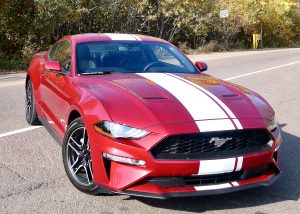Stick brings Rapid Red Mustang ‘Bob’ to life
Filed under: Weekly test drives, Autos
By John Gilbert
It’s often disappointing when my test-drive week with a particularly neat car comes to an end, but I found a way to ease the pain a few weeks ago, after driving the new mid-engined Corvette Sting Ray. When it arrived at my Duluth home, the Sting Ray was not alone. Also delivered was a very neat new Ford Mustang, painted Rapid Red Metallic with a bright white racing stripe running nose to tail, over the roof, and down the middle.
As if to test my overload skills, I wondered how I would spend adequate time in both cars during the upcoming week, but then I got a message: There had been a mistake, and the Corvette, which was in pre-production short supply, would only be with me for three days. Problem solved. I drove the heck out of the Corvette for that Monday, Tuesday and Wednesday without even getting into the Mustang, knowing that as soon as the guys showed up to take away the Sting Ray Thursday morning, I could climb into the Mustang and drive off over the horizon.
I have driven different Mustang models in recent years, including the Shelby GT500, the Shelby GT350, the Mustang GT, and the Mustang Bullitt, and with the racing stripe and a 6-speed manual transmission, and that new-generation ferocious look, I figured this must be a GT, at least. The information sheet said it was a Mustang “Premium,” which only meant that it had some upscale features, like dual exhausts, a rear spoiler, and other trim things.
Most impressively, when I took off down the road, I noticed the Mustang had excellent acceleration, and it handled with precision. I went back to the information sheet and, to my surprise, noticed that for an engine, it had a 2.3-liter 4-cylinder, with Ford’s Ecoboost system of turbocharging.
I have always regarded the Shelby GT350 and the Bullitt as my two favorite current-generation Mustangs to drive, but I will have to find room to squeeze this one in among them.
Ford has discontinued most of its cars, but the Mustang stays strong as an annual tribute to the pony car Ford brought out in 1965 to revolutionize American driving habits. Here was a 2-plus-2 coupe, very sporty looking and handling, for a bargain price. Everybody wanted one, and every other manufacturer hustled to come out with a competitor.
As power has risen higher and higher on the scope of sporty cars, it has become more and more apparent that we don’t need as much power as can be produced, but we could really have a lot of fun if the car handled as well as a sports car and could parlay adequate power into impressive fuel-economy numbers, especially with that 6-speed, right out of a GT350.
Ford recently announced that it is discontinuing the Shelby GT350, much to my disappointment, brecause the GT350 with 527 horsepower out of its 5.2-liter V8 is a lot of fun, if not as neck-snapping as the GT500 with its supercharged version of the 5.2 developing 760 horsepower.
I am here to suggest that the car I test-drove bridges the gap. The venerable 2.3-liter 4, when turbocharged, produces 310 horsepower at 5,500 RPMs and 350 foot-pounds of torque at 3,000 RPMs. Even with the Mustang having grown to 4,000 pounds these days, that’s enough power to make you not miss the V8’s extra oomph.
Ford has wisely dropped the V6, the previous base engine, and now uses the 2.3 as its base engine. But a look at the accompanying photos will make you realize that if it looks the part, goes with the force that the look promises, and handles great, we can save a lot of money by buying the Ecoboost 4. We liked the little toggle switches at the base of the center stack, controlling various functions including driving modes, from normal to sport. Read more



 John Gilbert is a lifetime Minnesotan and career journalist, specializing in cars and sports during and since spending 30 years at the Minneapolis Tribune, now the Star Tribune. More recently, he has continued translating the high-tech world of autos and sharing his passionate insights as a freelance writer/photographer/broadcaster. A member of the prestigious North American Car and Truck of the Year jury since 1993. John can be heard Monday-Friday from 9-11am on 610 KDAL(www.kdal610.com) on the "John Gilbert Show," and writes a column in the Duluth Reader.
John Gilbert is a lifetime Minnesotan and career journalist, specializing in cars and sports during and since spending 30 years at the Minneapolis Tribune, now the Star Tribune. More recently, he has continued translating the high-tech world of autos and sharing his passionate insights as a freelance writer/photographer/broadcaster. A member of the prestigious North American Car and Truck of the Year jury since 1993. John can be heard Monday-Friday from 9-11am on 610 KDAL(www.kdal610.com) on the "John Gilbert Show," and writes a column in the Duluth Reader.